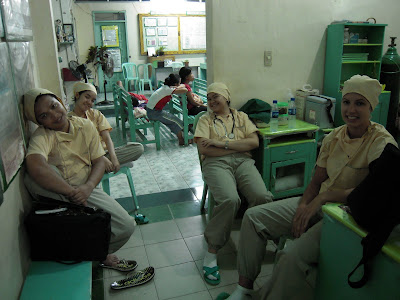Tuesday, January 26, 2010
After labouring over fire and coals for three hours, we were able to enjoy a “Canadian” meal with our Filipino friends. It was a challenging task having to cook for 22 people, and we were all covered in sweat and soot by the end, but it was a rewarding experience to share part of our culture with the students since they have shared so much with us.
After labouring over fire and coals for three hours, we were able to enjoy a “Canadian” meal with our Filipino friends. It was a challenging task having to cook for 22 people, and we were all covered in sweat and soot by the end, but it was a rewarding experience to share part of our culture with the students since they have shared so much with us.
 Following dinner, we began getting ready for bed, and received a call at 2100h from a midwife at the RHU clinic regarding a delivery that we were invited to attend. Jessica, Kirsten, Ashley, and Whitney quickly changed and ran (literally) to the clinic to participate in the delivery.
Following dinner, we began getting ready for bed, and received a call at 2100h from a midwife at the RHU clinic regarding a delivery that we were invited to attend. Jessica, Kirsten, Ashley, and Whitney quickly changed and ran (literally) to the clinic to participate in the delivery.When we arrived at the clinic, we discovered that there were two women labouring: one primpara who was in active labour, and one multipara who was walking around the clinic trying to progress through the labour process in a natural manner. While assisting in the two deliveries, we learned that at the RHU clinic all women deliver without analgesic. Also, labour is augmented through rubbing the woman’s nipples, stimulating the production of oxytocin, which enhances uterine contractions. Furthermore, 10U of oxytocin is administered IM following the delivery of the placenta.

From both lecture content and personal experience in the delivery room, we have noted that in Canada many women receive epidural analgesic during labour and delivery, are given IV syntocinon to augment uterine contractions, and receive additional oxytocin IM following the delivery of the baby’s anterior shoulder. Masking pain related to childbirth and augmenting contractions through synthetic pharmacological methods can be referred to as “medicalization”. Parry (2008) refers to medicalization as changing normal bodily states and processes into complicated, pathological events. Furthermore, Parry (2008) asserts that medicalization occurs when a biomedical field perceives natural life events such as labour and delivery to be risky and dangerous. Through experiencing traditional deliveries in a rural health center, we have come to appreciate the benefits of natural rather than medicalized birthing methods. This is because in Canada, the focus of labour and delivery has become viewed as a process of treating an illness state, which medical professionals are trained to “…determine, control, and rectify…” (Parry, 2008, p. 786). By approaching the birthing process as something that needs to be fixed or controlled, the success of the delivery and overall family experience can be negatively affected.

After experiencing two natural deliveries, we can see positive aspects that could be implemented in Canada. Some of these include: shifting our focus from progressing through the stages of labour in a timely manner to assisting and coaching the mother in transitioning through her personal birthing experience; and decreasing the overuse of pharmacological treatments during the birthing process. This would create a more meaningful and family-centered life event.
 Overall, this was a very exciting and rewarding experience since some of us have never experienced or assisted with deliveries before. We would like to thank the midwives, clinical instructors, and students for going the extra mile to make this experience possible!
Overall, this was a very exciting and rewarding experience since some of us have never experienced or assisted with deliveries before. We would like to thank the midwives, clinical instructors, and students for going the extra mile to make this experience possible!Pictured:
1. Whitney and Chelsea helping prepare the "Canadian" meal.
2. Jovan, Irina, Arielle, and Jessica wearing their labour and delivery scrubs waiting for the second delivery.
3. The birthing stretchers in the delivery room.
4. Infant assessment area and bassinette in the delivery room.
References
Parry, D. C. (2008). “We wanted a birth experience, not a medical experience”: exploring Canadian women’s use of midwifery. Department of Recreation and Leisure Studies, University of Waterloo, Waterloo, Canada 29, 784–806.
No comments:
Post a Comment